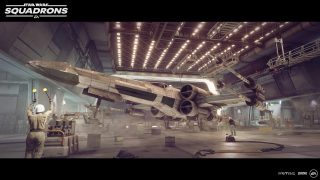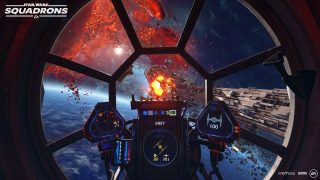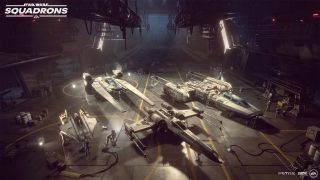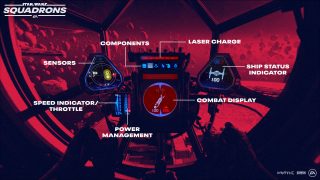YOUR STARFIGHTERS
PILOT BRIEFING
STAR WARS™: SQUADRONS

Welcome back, pilots. It’s been great to see the discussions you’ve all been having about Squadrons in the wake of the gameplay reveal. The team has been thrilled by the reception so far and we can’t wait for you to strap in at launch! Today, though, we wanted to get into the heart of this game: the starfighters and their core functions.
You’ll have eight starfighters at your disposal:
● T-65B X-wing starfighter
● BTL-A4 Y-wing assault starfighter/bomber
● RZ-1 A-wing interceptor
● UT-60D U-wing starfighter/support craft
● TIE/ln starfighter (“TIE fighter”)
● TIE/sa bomber (“TIE bomber”)
● TIE/in interceptor (“TIE interceptor”)
● TIE/rp reaper attack lander (“TIE reaper”)

While each of these starfighters have their own unique handling and functionality, there are some base features that they all share. Every ship has primary weapons, countermeasures, a hull outfitting, engines, and two auxiliary abilities (such as missiles or repair droids), though some starfighters also have shields. The benefit of this system is that if you know how to pilot one starfighter, you know how to pilot them all as they all share the same basic controls, too. Through these functions, players will be able to balance their power systems to face any confrontation.
POWER MANAGEMENT
One of the core features in Squadrons is the power management system that allows you to divert power to a particular subsystem: engines, lasers, or shields. For the most part, having balanced power will get the job done, but there’ll likely be times where you want to prioritize one system in particular. Raising the power diverted to one system will increase its efficiency while lowering it will do the opposite. Having one of the three systems at max power, though, will give your ship an otherwise unique ability that it can’t regularly perform. Players will have the option to choose between a basic, simplified power management system and a more advanced one that allows them to more precisely control how much power goes to each subsystem.

Diverting power to your engines increases your top speed, but if you have your engine power maxed out, you’ll be able to charge up and use a very powerful speed boost, not unlike what Poe Dameron used in Star Wars™: The Last Jedi or the X-wing pilot used in the reveal trailer for Squadrons.
Meanwhile, if you focus on diverting power to your lasers, they’ll recharge much faster. Should your weapon power be at max, you’ll automatically begin to overcharge your lasers, making them much more powerful before reverting to normal cannon fire. This also means you’ll have up to double the laser output available since you’ll first use the overcharge and then use regular laser fire. Just like the speed boost, they’ll continuously charge back up and then overcharge while not being used. This is great for attacking an enemy flagship subsystems or one of the cruisers that try getting in your way (Creative Director’s note: “Or just melting an enemy starfighter”).
For the New Republic ships and the TIE reaper, diverting power to shields allows them to recharge faster. If your shield strength is maxed out, though, you’ll charge up overshields (up to 200% shielding) for both the front and back of your starfighter, which is a lot of extra protection and useful when getting near turbolasers. Shields can also be focused on the front or back of the starfighter at any time, but without an overshield, that requires a trade-off of having up to 200% shields on one side but none on the other. This is good for when you’re rushing towards a flagship or while being chased by an enemy.
For starfighters that don’t have shields, however, there’s another option. Rather than being able to focus shielding to the front or back of your starfighter, you can instead use a power converter to rapidly divert all power from one part of the ship to another (for example, lasers to engines or engines to lasers). This is an effective response to an emergency situation where you need an immediate laser overcharge but are willing to have barely functioning engines, or an instant speed boost but with little to no offensive capabilities.
However, constantly having one of your starfighter’s power systems maxed out isn’t always wise. If your lasers are at full power, you’ll likely be moving slower and/or have weaker shields, for example. You’ll want to manage your power balance regularly to fit the situations you’re in so that you can stay in the fight longer. At any time, you’ll be able to rebalance your ship’s power to an evenly distributed state with a single button press, though, so it’s easy to recalibrate in the heat of battle.
Beyond that, hull integrity (or ship health) will also be something you’ll need to monitor. Your ship’s health will not automatically regenerate (unlike shields), and as your hull integrity drops from 100 towards 0, your ship will visibly become more damaged. However, there are ways to repair! Astromechs and repair systems are components that can restore some of your ship’s health. Additionally, returning to the hangar in a flagship will also fully repair your starfighter. And of course, Support ships are also excellent at helping allies stay in the fight by restoring their hulls. More on them below!
You’ll also want to know how to resupply as some components have limited ammo. Support starfighters can certainly help here and will be the best way to resupply on the go, but you can also fly under an allied cruiser or into the flagship’s hangar to restock your munitions, too. Regular lasers/weapons don’t require ammo and simply recharge over time, but countermeasures, torpedoes, mines, and other components have limited ammo. There are also some components, like astromechs, that recharge over time.
STARFIGHTER CLASSES

In total, there are four starfighter classes: Fighters, Bombers, Interceptors, and Support ships. Between the two factions, each class of ship is relatively balanced compared to its counterpart. The only major difference is that the four New Republic starfighters (X-, Y-, A-, and U-wings) plus the TIE reaper have shields while the other three TIEs do not. To compensate for this, these three TIEs have slightly higher speed, agility, and offensive capabilities and can also divert emergency power into either engines or lasers for a brief power surge as mentioned before.
Fighter-class ships are some of the most balanced ships. They’re good at dogfighting, quite agile, and can take a hit, making them exceptionally flexible starfighters that can adapt to any situation. Though they typically won’t excel in any one specific area like the other starfighters, they’re great as an all-purpose playstyle. The iconic X-wing and TIE fighter make up this class.
Meanwhile, Interceptor-class ships are uniquely tailored for dogfighting. These ships have very high speed and lasers to match, but they’re glass-cannons, too. They dish out a lot more damage than they can take, making them well-suited for hit-and-fade attacks or picking off enemy ships. The beloved A-wing and TIE interceptor make up this class.
Then there’s the Bomber-class starfighters which live up to their name. These ships, though slower moving, can take a lot of damage and deal out even more. You’ll want these in your squadrons when it’s time to do bombing runs on enemy flagships and their accompanying cruisers, but don’t underestimate them in a dogfight, either. While they aren’t as nimble or agile as other starfighters, they can reliably hold their own in a fight and can take down an enemy ship faster than most others, making them ideal frontline fighters. The hardy Y-wing and TIE bomber are part of this class.
And last but certainly not least are the Support-class starfighters. These ships are dedicated to keeping their allies in the fight by resupplying and repairing them, but are also uniquely suited for building out defensive and offensive capabilities. They have the ability to use tractor beams to stop or slow enemies, drop mines to entrap and take out foes, and deploy turrets on the go to bring some additional firepower to a location, changing the way both squadrons fight and fly. Though they’re less agile than other starfighters and don’t usually deal as much damage, they’re great at disabling enemy ships while helping their squadron, making them excellent to have on your wings for any engagement. The reliable U-wing and TIE reaper are the two in this ship class.
BRING THEM TO LIFE

Finally, let’s talk a bit about these iconic starfighters themselves. Recreating them as authentically as possible was a labour of love for the team, but so was finding a way to balance gameplay and design. Here’s what our Creative Director had to say on that:
Ian Frazier: A big part of our work in bringing these starfighters to life has been the creation of the cockpits. They're challenging, because we're trying to look as realistic as possible while matching the aesthetic from the films and incorporating the necessary gameplay information as naturally as possible. How do we convey the state of your shields or the status of your target, for instance, in a way that feels like it belongs in the Star Wars galaxy?
This means that when we want to communicate the charge level of your lasers in an X-wing, we design the cockpit instruments for that as if we were Industrial Light & Magic (ILM) building the prop in the '70s. We don't say "put a red light there," we say "if you needed to physically build this using the sorts of parts that ILM had, how would it be built? Is that light a bulb? An LED? How would it be integrated into the dashboard and how would its light interact with everything around it. We ensure the screens are CRTs with appropriately curved monitors, and so forth.
We also try to come at it from a purely fictional angle, pretending we're employees of Incom or Sienar Fleet Systems and then asking "how would we build this?" This was particularly the case with the TIEs, where there was no existing canonical guide [when we started development] as to how exactly those ships are piloted, which meant we needed to figure out the way things like the control yoke actually worked in a very practical sense. This was a ton of fun because it meant working with the team at Lucasfilm, animators, and mocap actors to land on an approach that fit with what we saw in the films but is believable in terms of how a real pilot would need to operate the controls to pull off complex maneuvers. (Editor’s note: We actually built cockpits for our actors when performing motion capture!)
One related thing worth a mention here is that when you start a new game of Squadrons (or later in the options menu), you can set the game to the "Instruments Only" mode. If you do, it turns off all the in-world UI elements (for highlighting objectives and so forth), so you become almost 100% reliant on your cockpit instruments. This definitely makes the game harder, so toggle it on with caution, but if you want to jack the immersion level to the max, it's pretty darn cool!
He’s not joking, either. It’s tough! Still, we have no doubts that some of you are going to master the diegetic dashboard (meaning most of the HUD is built into your cockpit). And if you want to get even deeper into the immersive experience, try a VR headset and wielding a trusty HOTAS setup if you’re on an applicable platform!
This concludes your pilot briefing, but there’s more to come. If there’s anything you really want us to go into, be sure to let us know, too! As always, you can also check out other pages on our website for more information about the game, such as one that details locations or even the game’s PC requirements. But until next time, fly safe!
See you in the stars, pilots.
***
Lucasfilm, the Lucasfilm logo, STAR WARS and related properties are trademarks and/or copyrights, in the United States and other countries, of Lucasfilm Ltd. and/or its affiliates. © & ™ 2020 Lucasfilm Ltd. All rights reserved.

